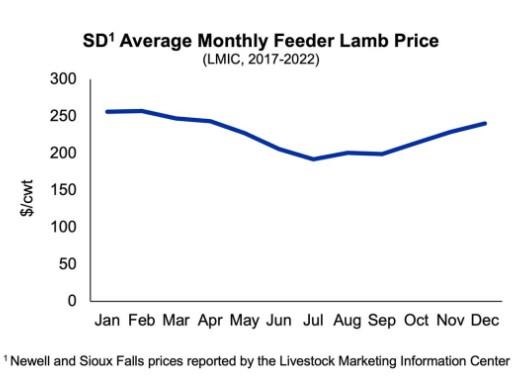By Jaelyn Quintana
Every year, as producers gear up to sell lambs, the age-old question is, “What is the market going to do?” Coming off a year of record prices across all classifications of sheep, the current drop in prices has been a bit discouraging. But, who’s to say what the lamb market will look like in six months. Using historic pricing data, we can observe seasonal price fluctuations that may make holding onto lambs a little longer a more profitable option. The cheapest feed source is pasture, which also promotes slower growth to extend lambs to a more ideal market. Therefore, if we can capitalize on a low-cost, low-growth feedstuff, once those lambs are sold and enter the feedlot, compensatory gain will boost those lambs to finish quickly without being excessively fat.

Historically, lamb prices drop in the summer as the supply of feeder lambs being sold into the commodity market increases. This is due, in part, to the fact that, 85% of U.S lambs are born in the first five months of the year. While the reproductive cycle is seasonal, the harvest level stays relatively consistent. Prices then begin to climb again in the fall and peak before the Easter holiday.
With the greatest demand for current lambs in the spring and continued slaughter throughout the summer, feeders are tasked with extending lambs on a high-concentrate ration. However, as a producer, you can capitalize on these price fluctuations and retain lambs on relatively low-cost pasture and prevent excessively fat lambs from entering the supply chain.
Quality of dormant grasses and growing lamb requirements
In South Dakota, the cost of running sheep on rangeland is approximately $0.30 per head per day (SD Agricultural Land Market Trends). With greater harvested feed costs, grazing lambs on range can be a cost-effective way to extend them to higher market seasons. However, it does require some additional protein supplementation. As we increase rate of gain, a greater percentage of the diet needs to be protein (Table 1). Declining rangeland quality often coincides with weaning, which makes meeting requirements a challenge but promotes slower growth rates (0.2 to 0.4 lb./d). Dormant forages are usually deficient in crude protein (4 to 8%), which is a critical nutrient for lamb growth and rumen development. Requirements can be met by supplementing with at least 0.5 to 0.75 lbs. of a high quality (18 to 20% CP) protein source, i.e. distillers grains, alfalfa, pellets, etc. Early weaning lambs at 90 days of age or younger can also save feed costs, since lambs are smaller and ewes are moved into maintenance rather than lactation. However, it’s recommended that early weaned lambs be at least 40 lbs. and have been exposed to grazing and consuming supplement. Of course, this option is only viable if you still have pasture available without overgrazing.
TABLE 1. NUTRIENT REQUIREMENTS OF GROWING LAMBS AT LOW GAINS (NRC, 2007)
Weight
(lb.) | Desired rate of gain
(lb./day) | Dry matter intake
(lb./day) | CP
(lb./day) | CP
(% of diet) | TDN
(lb./day) |
| 44 | 0.22 | 1.26 | 0.17 | 13% | 0.66 |
| 44 | 0.44 | 1.30 | 0.26 | 20% | 0.86 |
| 66 | 0.44 | 2.32 | 0.30 | 13% | 1.23 |
| 66 | 0.55 | 1.68 | 0.32 | 19% | 1.10 |
Putting it all together
Now, let’s connect all the dots. If you typically market your feeder lambs at 60 lbs. in August with a 5-year average (2017-2022) price around $2.25/lb., those lambs are worth approximately $135/head (LMIC, 2022). If you retain ownership of your lambs until November (60 days) on pasture, supplementing 0.5 lb. of DDG’s per day, the cost/hd/day is approximately $0.36 (Davis, 2022; USDA, 2022). This brings total per head feed cost to $22.60. At a rate of gain at 0.4 lb./day, those lambs in November weigh 84 lbs. valued at $172/hd. Less the feed cost, that’s an additional $15.40/head you earn. Assuming the additional risk involved, even with a 5% death loss, you still come out ahead in terms of overall revenue. To help mitigate disease risk, you also may consider CD+T (~$0.40/dose) prior to switching diets, deworming (~$0.20-$0.40/dose) and vaccinating lambs for respiratory diseases, such as Manheimia haemolytica and Pasturella multocida (~$0.80/dose).
Post grazing feedlot performance
Lambs fed forage-based diets prior to entering a feedlot are optimal for feed efficiency and meeting consistent harvest demand. Compensatory gain is the rapid increase in rate of gain when an animal is switched from a low to high plane of nutrition. This allows lambs fed low-quality forage prior to going into a feedlot to have greater average daily gains on high-energy rations. In terms of weight, they are able catch up to lambs that have already been on a concentrate diet. Lambs fed forage prior to concentrates are also leaner. During years when there is a backlog of lambs in feedlots, extended time on high-corn diets increases fat deposition, and ultimately leads to heavier, fatter carcasses. Preventing excessively finished carcasses benefits all sectors of the industry to maintain lamb quality.
Retaining ownership of lambs to take advantage of higher market prices can be an economical option. However, you must consider the need for protein supplementation and be willing to take on additional labor and risk. Even with prices taking a hit in recent weeks, historically, prices should rise for feeder lambs, and better drought outlooks should support lower feed costs.
Seasonality of Prices
Source : sdstate.edu